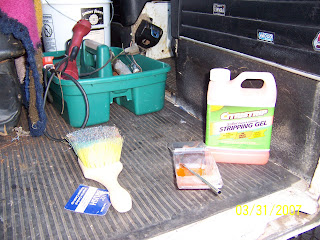 brought this Bus home, even the reverse lights. The right rear taillight did develop some funkyness, though, after I'd driven it a couple of times.
brought this Bus home, even the reverse lights. The right rear taillight did develop some funkyness, though, after I'd driven it a couple of times.As it turned out, the socket was really tired. One of the spring-loaded contacts inside had collapsed, & no amount of fiddling would put the bulb in a position where it would light reliably.
Bus Depot has new repro taillight assemblies, of course, & at $20 a pop, they're even not too expensive, but I kept wondering if I couldn't do something with what I had on hand.
Fortunately, I had a used repro taillight asembly to play with, & I'm posting the results here in case they might be useful.

My other ride is an '85 Dodge Ramcharger, another rust-free Southern survivor that nonetheless has the corrosion issues common to 22-year-old vehicles. I've replaced a couple of turn signal sockets, & I'm always on the lookout in our local self-serve junkyard for more, since it's difficult to find good-quality repros. The socket in the last one I bought was so loose, I couldn't make it work, & ended up going to the junkyard for a used one. That's when I started collecting them.
I collect weird things.
These sockets can be found on early to mid-80's Dodge trucks, and also on Jeeps of the same vintage.
The wiring configuration is the same as on a Bus: one ground lead, & two hot l
 eads, one for the taillight, one for the turn signal. The bulb is the same, too: a dual-element GE# 1157.
eads, one for the taillight, one for the turn signal. The bulb is the same, too: a dual-element GE# 1157.The VW socket attaches to the back of the taillight with two metal tabs which are easily bent aside, allowing the socket to be removed (Sorry, don't have a pic of that; camera battery pooped out).
That leaves a flat surface with a hole in it which just has to be enlarged a bit & shaped with the proper slots for the Chrysler-style socket:
You can see here the tools I used to shape the hole: a Dremel with a co
 uple of stones, a triangular file, a round chain saw file, & a half-round miniature needle file.
uple of stones, a triangular file, a round chain saw file, & a half-round miniature needle file.Once I'd cut the hole to match the shape of the Chrysler socket, it slotted in nicely with just a small counter-clockwise twist to secure it. There's a gasket that Chrysler uses between the plastic socket and the metal housing; since the metal in the VW housing was thinner than whatever one the Chrysler socket had been in, I had to use two gaskets to make up the gap. I was lucky to have several sockets with gaskets on hand.
If you try this, you should try to find an extra gasket, or maybe pull a couple of sockets. the ones I got cost me $3.00 each a
 t the local u-pull junkyard. I've bought them at other yards for as little as $1.00.
t the local u-pull junkyard. I've bought them at other yards for as little as $1.00.It isn't stock, but I think this socket represents an improvement. It's much more weatherproof than the original, and it allows for bulb replacement without removing the taillight lens -- just twist & pull the socket out, change the bulb, & twist & push it back in! Best of all, if you use male spade terminals on the end of the pigtails, you can connect to the female spade terminals on your VW harness without cutting into the stock wiring. I wrapped the connections with self-fusing rubber tape to waterproof them. I can pull it all apart & connect an unmodified stock taillamp assembly any time I want.
Now, I'm waiting for my other socket to fail, so I can modify the left side la
 mp, too!!
mp, too!!

















